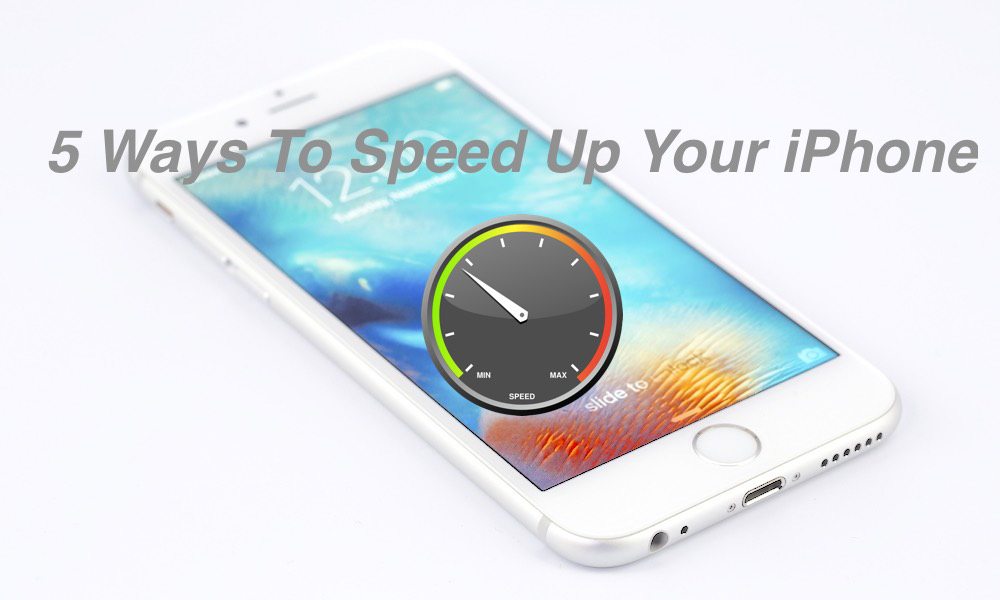5 Quick and Easy Ways to Speed Up Your iPhone

Toggle Dark Mode
Apple’s iPhone is arguably the company’s most successful, beloved product of all time. Not only are they aesthetically pleasing to look at, constructed of the most premium materials planet Earth has to offer, but iPhones are also among the fastest, most fluid smartphones money can buy.
Of course, as with everything in life, sometimes they tend to slow down on us the more we use them. The longer your iPhone is in your possession, handling tasks and keeping you connected to what matters most, they’re going to accumulate data and content and the general mileage typical of any tangible good that’s used day in and day out.
Fortunately, there are litanies of ways in which you can get your iPhone humming along like new again. Check out our recommendations for the top 5 ways to make your iPhone run faster and more seamlessly than ever before. And if you feel like learning more, head to 6 ways to free up memory in order to speed up your iPhone as well as how clearing mysterious “Other Data” can speed up your iPhone or iPad.
1. Clear Your RAM
iPhones aren’t the most beastly handsets in the RAM department, and most of the latter-year handsets only boast either 1, 2, or 3 GB, depending on the model. Sure, even though the iPhone is historically known to utilize a lower amount of RAM than its Android-running rivals, there’s no rule of thumb saying you can’t speed it up on your own, and noticeably so, depending on how many apps or behind-the-scenes processes you have running in the background.
To clear your iPhone’s RAM, simply press-hold on the handset’s power button until the ‘Slide to Power Off’ option appears; then, release your finger from the power button, and press-hold the Home button for roughly 15 seconds, or until the screen view reverts back to your home screen.
2. Reboot Your Device
In some instances, a sluggish iPhone can be sped up a bit by simply rebooting it. To do this, simply press-hold on the Power and Home buttons at the same time for 30 seconds, or until the device physically shuts off and boots back up again.
See reboot directions for iPhone 7 and 7 Plus here.
3. Enable ‘Reduce Motion’
In case you haven’t noticed, iPhone is pretty heavy on the fancy schmancy UI animations. Performing basic tasks, such as getting back to the home screen or opening and navigating between apps, display a zoom in-zoom out animation as you either enter or leave that app. And unfortunately, those animations can consume a fairly significant deal of resources (mainly RAM) on your device.
But a really cool accessibility feature baked into iOS 9 or later will now allow you to essentially shut those animations off. The result? Apps open faster, and you can navigate the iOS platform much quicker, too, albeit at the expense of seeing any cool animations when you jump around from app to app.
Head to Settings > General > Accessibility > and then scroll down to select Reduce Motion. Lastly, toggle the feature On. You’ll likely notice that navigating is more seamless and doesn’t take as long. Try it out. Worst-case scenario, you don’t like it, you can always go back and toggle the feature ‘Off’ again by following the steps above.
4. Change Background App Refresh Settings
If you have a multitude of apps installed on your device, chances are they may be sucking away at your precious battery life and slowing down your iPhone in the process — since the device might be constantly refreshing either one (or all) of those apps behind the scenes, without you even realizing it.
If you’re not using an app, or you don’t use it often enough, you can always go in and play around with these settings by simply navigating to Settings > General > Background App Refresh > and then scanning the list of downloaded apps to decide which apps, if any, that you’d like to allow to refresh in the background.
5. Delete Unused Apps or Games You Almost Never Play
With millions of apps available to download from the Apple App Store, chances are you’ve got a fairly substantial number of them installed on your own device — of course, that doesn’t necessarily mean you’re actually using them all, right? Fortunately, going through and deleting any unused or infrequently used apps will not only clear extra space on your device, but could also allow your iPhone to run a bit quicker.
To simplify the process, simply navigate to Settings > General > Storage & iCloud Usage. Under the ‘Storage’ section, select ‘Manage Storage’, and then select the apps you want to delete, one-by-one, by tapping on them as you move down the list and selecting Delete App. Read Related: 6 Ways to Free Memory and Speed Up Your iPhone & How to Erase Mysterious “Other Data” to Speed Up Your iPhone or iPad






